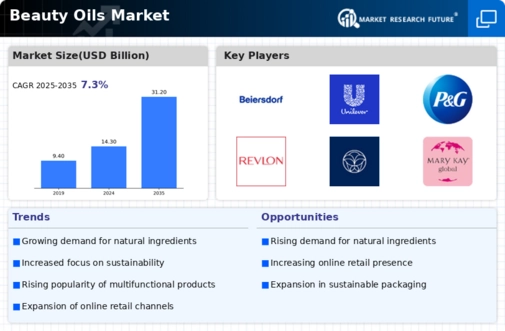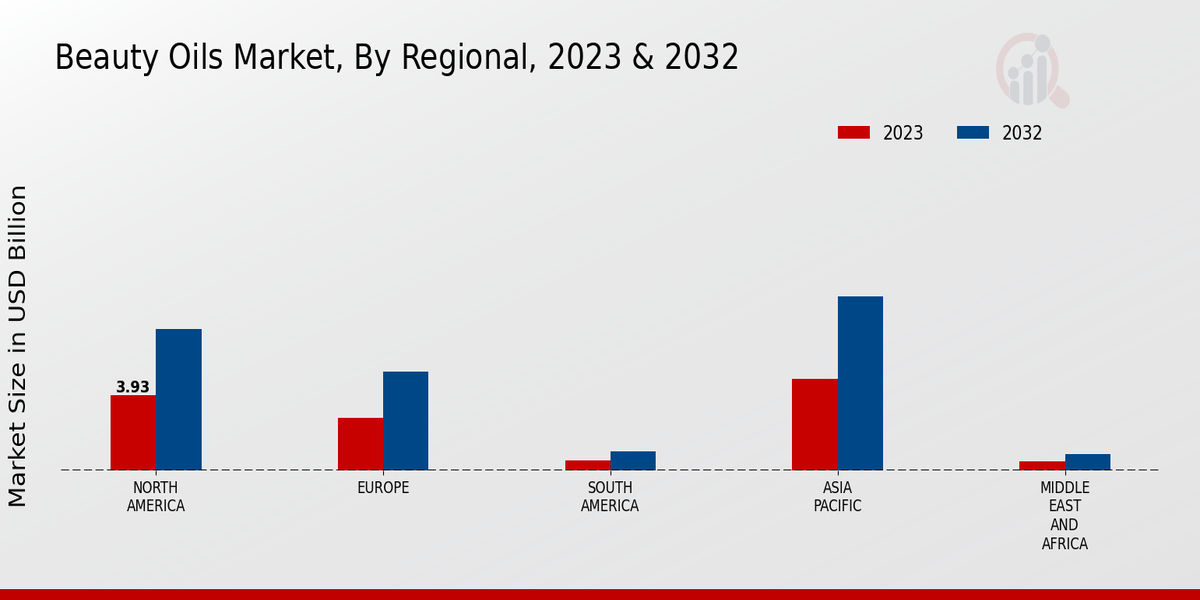Market Growth Projections
Growing Awareness of Skin Health
The Global Beauty Oils Market Industry benefits from an increasing awareness of skin health and wellness among consumers. As individuals become more conscious of their skincare routines, the demand for beauty oils that offer specific benefits, such as hydration, anti-aging, and skin repair, is on the rise. This awareness is often fueled by social media influencers and dermatologists advocating for the use of beauty oils in daily skincare regimens. Consequently, the market is projected to grow at a CAGR of 7.32% from 2025 to 2035, reflecting the sustained interest in products that promote skin vitality and overall health.
Expansion of E-commerce Platforms
The Global Beauty Oils Market Industry is witnessing a significant transformation due to the expansion of e-commerce platforms. Online retailing provides consumers with easy access to a diverse range of beauty oils, facilitating informed purchasing decisions through product reviews and detailed descriptions. This trend is particularly relevant in regions where traditional retail channels are limited. The convenience of online shopping, coupled with targeted marketing strategies, enhances consumer engagement and drives sales. As e-commerce continues to flourish, it is anticipated that the market will reach a valuation of 31.2 USD Billion by 2035, highlighting the pivotal role of digital platforms in shaping consumer behavior.
Diverse Applications in Personal Care
The Global Beauty Oils Market Industry is characterized by the diverse applications of beauty oils across various personal care segments. These oils are not only utilized in skincare but also find applications in hair care, aromatherapy, and massage therapies. The versatility of beauty oils appeals to a broad consumer base, as they can serve multiple purposes, enhancing their marketability. This multifaceted usage contributes to the overall growth of the industry, as consumers seek products that offer comprehensive benefits. The expanding range of applications is likely to support the market's upward trajectory, fostering innovation and product development.
Rising Demand for Natural Ingredients
The Global Beauty Oils Market Industry experiences a notable surge in demand for natural and organic beauty products. Consumers increasingly prefer products that are free from synthetic chemicals, leading to a shift towards beauty oils derived from natural sources. This trend is driven by heightened awareness of the benefits of natural ingredients, which are perceived as safer and more effective. For instance, oils such as argan, jojoba, and coconut are gaining popularity for their nourishing properties. This shift is expected to contribute to the market's growth, with projections indicating a market value of 14.3 USD Billion in 2024, reflecting the growing consumer inclination towards natural beauty solutions.
Influence of Social Media and Beauty Trends
The Global Beauty Oils Market Industry is significantly influenced by social media platforms and emerging beauty trends. Influencers and beauty enthusiasts frequently share their experiences with various beauty oils, creating a ripple effect that drives consumer interest and purchasing behavior. The visual nature of platforms like Instagram and TikTok allows for the effective promotion of beauty oils, showcasing their application and benefits. This trend not only enhances brand visibility but also encourages consumers to experiment with new products. As a result, the market is poised for continued growth, with a strong emphasis on innovative marketing strategies that leverage social media engagement.




















